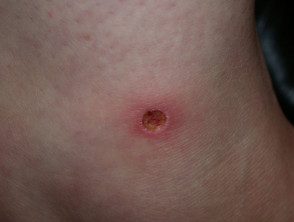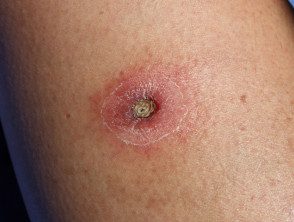What is ecthyma?
The ecthyma is a skin. infection characterized by crusted sores under which ulcers to form. It is a deep form of impetigo, like itself bacteria causing the infection are involved. The ecthyma causes deeper erosions of the skin in the dermis.
Streptococcus pyogenes and Staphylococcus aureus are the bacteria responsible for the ecthyma.




See more images of ectima.
Who gets ecthyma?
People of all ages, sex and race may be affected, although children, the elderly, and immunocompromised patients (eg diabetes, neutropenia, immunosuppressive medication, malignancy, HIV) tend to have a higher probability of infection. Other factors that increase the risk of ecthyma include:
- Poor hygiene and crowded living conditions.
- High temperature and humidity in tropical places
- Presence of minor injuries or other skin conditions, such as scratches, insect bites or dermatitis
- Untreated impetigo, particularly in patients with poor hygiene.
What are the signs and symptoms of ecthyma?
The ecthyma most often affects the buttocks, thighs, legs, ankles, and feet. Occasionally, the local lymph nodes swell and hurt.
Ecthyma injury generally starts as a vesicle (small blister) or a pustule in an inflamed area of the skin.
- A hard Cortex soon covers the blister.
- With difficulty, the bark can be removed to reveal a indurated ulcer it may be red, swollen and oozing pus.
- The lesions may remain fixed in size and sometimes resolve spontaneously without treatment, or they may gradually enlarge to a 0.5 to 3 cm diameter sore.
- They resolve slowly leaving a scar.
Ecthyma complications
Ecthyma complications can include:
- Plus extended infection: cellulite, erysipelas, lymphangitis, gangrene, lymphadenitisand bacteremia
- Permanent scars
- Rarely, post-streptococcal glomerulonephritis.
What is the treatment for ecthyma?
Treatment depends on the extent and severity of the infection. Any underlying skin disease or infection, such as scabies or dermatitis, should also be treated.
Soak the crusted areas
Soak a clean cloth in a mixture of half a cup of white vinegar in one liter of warm water. Apply the compress to wet areas for about ten minutes several times a day. Gently wipe off the scabs.
Current antiseptics or antibiotics
A topical antibiotic ointment like fusidic acid or> mupirocin is often prescribed for located ecthyma A topical antiseptic such as povidone-iodine, superoxidized solutionantibacterial Manuka honey or hydrogen peroxide cream can be used instead. Apply it at least three times a day to the affected areas and the surrounding skin. The treatment should be applied after removing the scabs. Look carefully for new injuries to treat. Continue for several days after healing.
Oral antibiotics
Oral antibiotics are recommended if the infection is extensive or if the response to topical antibiotics is slow. The antibiotic of choice is a penicillin, usually dicloxacillin or flucloxacillin, which are active against both Streptococcus pyogenes and Staphylococcus aureus. The duration of treatment varies; It may take several weeks of therapy to completely resolve the ecthyma.
Improve hygiene
Another critical factor to consider in general ecthyma management is improving hygiene. The steps to take include:
- Daily wash with antiseptic soap or cleanser
- Change and wash clothes and bedding frequently
- Use separate towels and flannels to prevent the spread of infection.
- Use repellent nets and sprays to prevent insect bites.
- Reduce scratching from insect bites, chickenpox blisters, and scabies by applying calamine lotion, colloidal oatmeal or baking soda.

